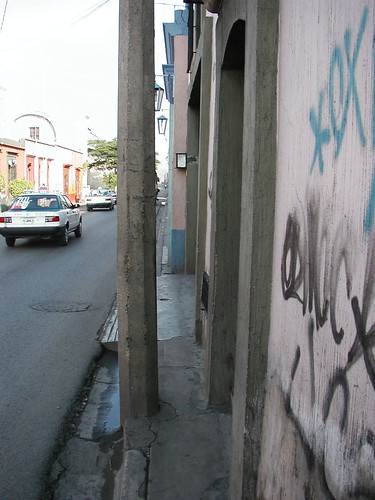July 23, Friday - My brain is full

Skinny sidewalk
9 pm
My brain is filled with so much new information. It seems like seeing and hearing and smelling so much new stuff actually makes it harder for me to learn Spanish, because I swear that my brain fills up. Sometimes there is just no more room!
This morning almost the whole school went on a field trip to Ocotlan.
Luz wanted me to stay at school for class, but I was determined to take a little break and get out of Oaxaca. I was tired of conjugating verbs.
I had heard the market at Ocotlan was amazing and very traditional, so I wanted to go wander around in it and see what interesting things I could find.
It didn't work out that way, though. Luis was the tour leader and did everything at a dead run - he had a lot of stops he wanted to make and left no time to dilly-dally around the marketplace.
I didn't know how we were going to get there. I imagined we might take a hired van out there - Ocotlan is about 20 miles - but we all trooped down the street to a second-class bus terminal and waited for a bus.
Our bus adventure
The terminal would be comparable to a Greyhound station, if a Greyhound station were outside and didn't have any soldiers or crackheads...
The seats for waiting for the bus were all outside under a tin roof, and the fares were painted on the wall. The fare to Ocotlan was 10 pesos - slightly under a buck.

Bus ticket
We went out of the city through fields and hills. Tiny cattle, about 1/3 the size of our big Anguses, grazed beside roads and we saw oxen being used to plow fields.
There were also fields of maguey (agave), which are used to make the ever-popular mezcal. They are also used for tequila, but not here, usually - in Oaxaca it is all about the mezcal. I don’t know what makes the two drinks taste so different.
There is a saying "Para todo mal, Mezcal. Para todo bien, tambien," which means "For everything bad, mezcal. For everything good as well."
Much of the road was lined with shops, tiny open-fronted buildings in all colors selling everything from beer to pottery to tires.
In some places, tiny Indian women walked barefoot along the road in traditional dress, carrying woven basket trays of food on their heads or in their arms.
Many women - not so many men - here wear traditional dress. Handwoven cotton, linen or wool outfits are made in patterns specific to certain regions, so people who see them know immediately where they came from. Some are very subtle, especially the woven huipiles, which are a simple dress that looks like one long piece of material, folded over and stitched along the seams with a hole for the head and simple arm holes.
Others, like the famous San Antonio wedding dresses, are covered in huge, bright bold embroidered flowers on a black or red velvet backing. They are psychedelic and outrageous, like nothing I have ever seen before.
The bus had ancient, seats with the fabric worn and dirty. The windows were covered with graffiti carved in the plexiglas.

0 Comments:
Post a Comment
<< Home